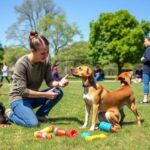When it comes to managing your dog's aggression, understanding the underlying triggers is vital. You'll find that identifying these triggers, whether they stem from fear or anxiety, can greatly affect your approach. By observing your dog's body language, you can gauge their comfort levels and respond appropriately. Creating a safe environment is essential, but it's only the beginning. What positive reinforcement techniques can you implement to reshape behavior, and how might socialization play a role in this process? The answers may surprise you as you explore deeper strategies for effective management.
Understanding Aggression Triggers
Aggression triggers can often feel like unexpected landmines in everyday life. You might encounter them during walks, at home, or even during playtime. Recognizing these triggers is vital for effective training. Think about the situations that make your dog react aggressively. Is it the presence of other dogs, loud noises, or even certain people?
Pay attention to your dog's body language. Signs like raised hackles, stiff posture, or growling indicate discomfort or fear. These signals can help you identify what's causing the aggression. Once you spot these triggers, you can start to manage them.
Consider creating a list of specific situations that lead to aggressive behavior. This way, you can plan ahead and avoid these scenarios until your dog learns to cope better.
Also, remember that aggression often stems from fear or anxiety. Understanding the root cause is fundamental for developing an effective training strategy.
Assessing Your Dog's Behavior
How can you effectively evaluate your dog's behavior to better understand their aggression? Start by observing your dog in various situations.
Take note of their body language, vocalizations, and interactions with people and other animals. Signs of aggression can include growling, barking, raised hackles, and a stiff body posture. Pay attention to specific triggers, like strangers approaching or other dogs nearby.
Next, document your dog's reactions. Is their aggression consistent in certain environments or with specific stimuli? This information will help you identify patterns in their behavior.
Try to gauge their comfort level in different situations—do they seem anxious, fearful, or overexcited?
Additionally, consider the context of their aggression. Are they defending territory, feeling threatened, or playing? Understanding the motive behind their behavior is essential for addressing it appropriately.
You might also want to consult with a professional trainer or behaviorist. They can provide insights and tools tailored to your dog's unique needs.
Creating a Safe Environment
To foster a peaceful atmosphere for your dog, start by identifying and minimizing potential stressors in your home. This could include loud noises, sudden movements, or other animals that may be unsettling. Create a designated safe space where your dog can retreat when feeling overwhelmed.
Next, establish a consistent routine. Dogs thrive on predictability, so regular feeding, walking, and playtimes can help reduce anxiety. Additionally, consider the environment's layout. Guarantee your dog has easy access to their essentials while also having quiet areas to relax.
Here's a quick guide to potential stressors to address:
| Potential Stressor | Solution | Notes |
|---|---|---|
| Loud Noises | Use calming music | Helps drown out distractions |
| Sudden Movements | Train family members | Encourage slow movements |
| Other Pets | Gradual introductions | Supervise initial meetings |
Positive Reinforcement Techniques
Positive reinforcement is one of the most effective ways to shape your dog's behavior and encourage desirable actions. By rewarding your dog for good behavior, you're not only reinforcing that behavior but also building a stronger bond with your furry friend.
Here are some techniques you can use:
- Use Treats: Always have tasty treats on hand. When your dog displays positive behavior, reward them immediately with a treat. This helps them associate the behavior with something they love.
- Praise and Affection: Sometimes, a simple "Good boy!" or a gentle pat is all it takes. Dogs thrive on your approval, so don't hesitate to shower them with affection when they behave well.
- Consistency is Key: Make sure everyone in your household uses the same commands and rewards. Consistency helps your dog understand what behaviors are expected, making reinforcement more effective.
Socialization Strategies
Regularly exposing your dog to different environments, people, and other animals is essential for effective socialization. Start with controlled experiences, like inviting friends over or visiting dog-friendly parks. This helps your dog learn to interact positively with various stimuli.
Introduce new sights, sounds, and smells gradually. For instance, take short trips to bustling areas, like markets or busy streets, to acclimate your dog to different atmospheres. Be certain to monitor your dog's reactions; if they seem overwhelmed, take a step back and try again later.
Encourage positive interactions with other dogs by organizing playdates with well-behaved, vaccinated pets. Supervise these encounters to guarantee safety and reinforce good behavior with treats and praise.
Also, consider using puppy classes or socialization groups. These environments provide structured opportunities for your dog to meet others while learning important skills.
Lastly, don't forget the importance of ongoing exposure. Socialization isn't just a one-time event; it's a continuous process. Regularly challenge your dog with new experiences to build their confidence and reduce aggressive tendencies.
Embrace the journey, and you'll see the rewards in your dog's behavior.
Professional Training Options
While socialization lays the groundwork for a well-adjusted dog, professional training options can take your efforts to the next level. Engaging a professional trainer can provide you with tailored strategies that address your dog's specific aggression issues.
Experienced trainers have the skills to guide you through complex behaviors, ensuring both you and your dog feel confident in your interactions.
Here are some professional training options you might consider:
- Group Classes: These classes offer socialization opportunities while under expert supervision, helping your dog learn to interact positively with others.
- Private Sessions: One-on-one training can target your dog's unique challenges, allowing for a customized approach that fits your schedule and needs.
- Behavioral Workshops: These workshops often explore deeper into understanding canine aggression, equipping you with knowledge and techniques to handle situations effectively.
Monitoring Progress and Adjustments
Tracking your dog's progress is essential for effective aggression training. Keeping a close eye on their behavior and responses allows you to identify what's working and where adjustments are necessary. Regularly monitor their reactions in various situations, and document these observations to create a clear picture of their development.
Here's a simple way to track progress:
| Date | Behavior Observed | Adjustments Made |
|---|---|---|
| 01/01/2023 | Barking at strangers | Increased distance during walks |
| 01/15/2023 | Growling at other dogs | Introduced controlled playdates |
| 02/01/2023 | Calm around new people | Maintained current routine |
| 02/15/2023 | Less fear during vet visits | Positive reinforcement used |
Regularly reviewing this information helps you understand patterns in your dog's behavior. If certain triggers persist, consider adjusting your training methods or consulting a professional. By consistently monitoring progress, you'll be better equipped to guide your dog toward more positive interactions, reducing aggressive tendencies over time. Remember, patience is key, and every small improvement counts!
Conclusion
By mastering the art of understanding and managing your dog's aggression, you're not just training a pet; you're weaving a tapestry of trust and safety. Embrace the journey—each step, from recognizing triggers to celebrating small victories, brings you closer to a harmonious bond. As you nurture your dog's growth, remember that patience is your guiding star, illuminating the path toward a peaceful coexistence. Together, you can transform aggression into understanding, crafting a brighter future for both of you.



